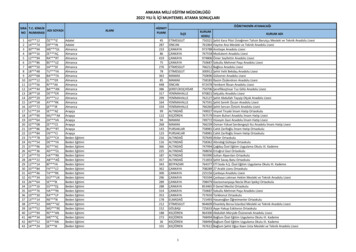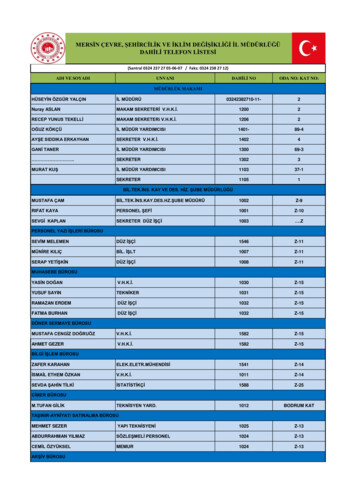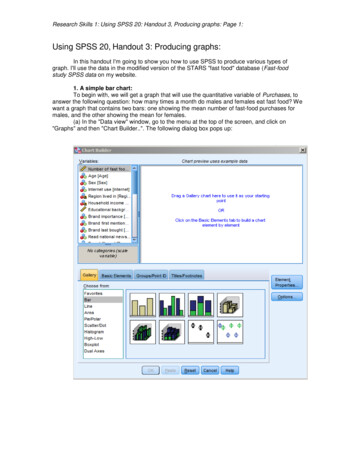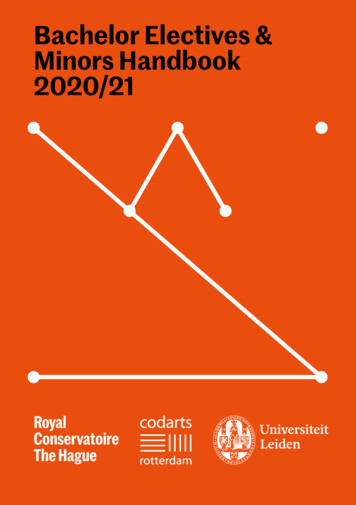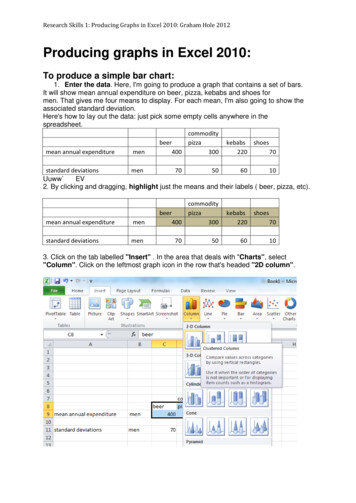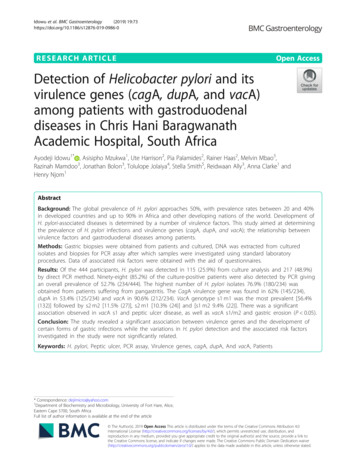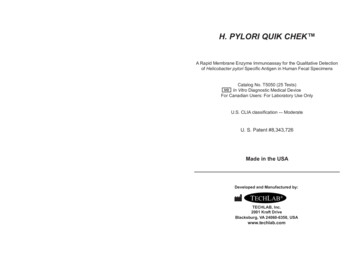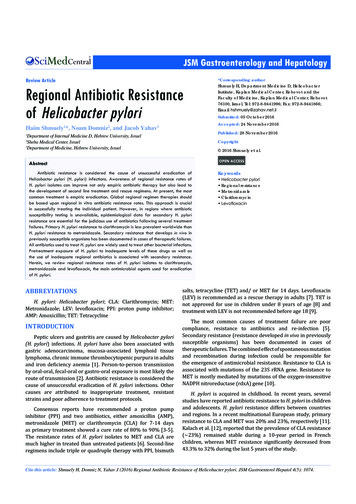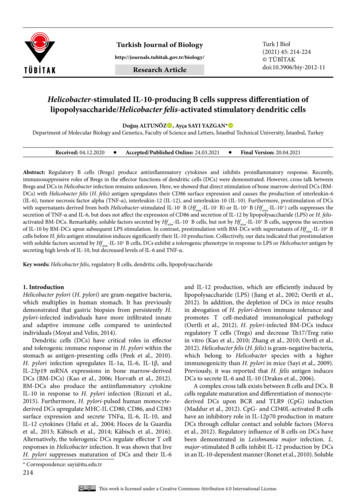
Transcription
Turkish Journal of arch ArticleTurk J Biol(2021) 45: 214-224 lated IL-10-producing B cells suppress differentiation oflipopolysaccharide/Helicobacter felis-activated stimulatory dendritic cellsDoğuş ALTUNÖZ , Ayça SAYI YAZGAN* Department of Molecular Biology and Genetics, Faculty of Science and Letters, İstanbul Technical University, İstanbul, TurkeyReceived: 04.12.2020Accepted/Published Online: 24.03.2021Final Version: 20.04.2021Abstract: Regulatory B cells (Bregs) produce antiinflammatory cytokines and inhibits proinflammatory response. Recently,immunosuppressive roles of Bregs in the effector functions of dendritic cells (DCs) were demonstrated. However, cross talk betweenBregs and DCs in Helicobacter infection remains unknown. Here, we showed that direct stimulation of bone marrow-derived DCs (BMDCs) with Helicobacter felis (H. felis) antigen upregulates their CD86 surface expression and causes the production of interleukin-6(IL-6), tumor necrosis factor alpha (TNF-α), interleukin-12 (IL-12), and interleukin-10 (IL-10). Furthermore, prestimulation of DCswith supernatants derived from both Helicobacter-stimulated IL-10– B (Hfstim-IL-10– B) or IL-10 B (Hfstim-IL-10 ) cells suppresses thesecretion of TNF-α and IL-6, but does not affect the expression of CD86 and secretion of IL-12 by lipopolysaccharide (LPS) or H. felisactivated BM-DCs. Remarkably, soluble factors secreted by Hfstim-IL-10– B cells, but not by Hfstim-IL-10 B cells, suppress the secretionof IL-10 by BM-DCs upon subsequent LPS stimulation. In contrast, prestimulation with BM-DCs with supernatants of Hfstim-IL-10 Bcells before H. felis antigen stimulation induces significantly their IL-10 production. Collectively, our data indicated that prestimulationwith soluble factors secreted by Hfstim-IL-10 B cells, DCs exhibit a tolerogenic phenotype in response to LPS or Helicobacter antigen bysecreting high levels of IL-10, but decreased levels of IL-6 and TNF-α.Key words: Helicobacter felis, regulatory B cells, dendritic cells, lipopolysaccharide1. IntroductionHelicobacter pylori (H. pylori) are gram-negative bacteria,which multiplies in human stomach. It has previouslydemonstrated that gastric biopsies from persistently H.pylori-infected individuals have more infiltrated innateand adaptive immune cells compared to uninfectedindividuals (Moyat and Velin, 2014).Dendritic cells (DCs) have critical roles in effectorand tolerogenic immune response in H. pylori within thestomach as antigen-presenting cells (Peek et al., 2010).H. pylori infection upregulates IL-1α, IL-6, IL-1β, andIL-23p19 mRNA expressions in bone marrow-derivedDCs (BM-DCs) (Kao et al., 2006; Horvath et al., 2012).BM-DCs also produce the antiinflammatory cytokineIL-10 in response to H. pylori infection (Rizzuti et al.,2015). Furthermore, H. pylori-pulsed human monocytederived DCs upregulate MHC-II, CD80, CD86, and CD83surface expression and secrete TNFα, IL-6, IL-10, andIL-12 cytokines (Hafsi et al., 2004; Hoces de la Guardiaet al., 2013; Käbisch et al., 2014; Käbisch et al., 2016).Alternatively, the tolerogenic DCs regulate effector T cellresponses in Helicobacter infection. It was shown that liveH. pylori suppresses maturation of DCs and their IL-6and IL-12 production, which are efficiently induced bylipopolysaccharide (LPS) (Jiang et al., 2002; Oertli et al.,2012). In addition, the depletion of DCs in mice resultsin abrogation of H. pylori-driven immune tolerance andpromotes T cell-mediated immunological pathology(Oertli et al., 2012). H. pylori-infected BM-DCs induceregulatory T cells (Tregs) and decrease Th17/Treg ratioin vitro (Kao et al., 2010; Zhang et al., 2010; Oertli et al.,2012). Helicobacter felis (H. felis) is gram-negative bacteria,which belong to Helicobacter species with a higherimmunogenicity than H. pylori in mice (Sayi et al., 2009).Previously, it was reported that H. felis antigen inducesDCs to secrete IL-6 and IL-10 (Drakes et al., 2006).A complex cross talk exists between B cells and DCs. Bcells regulate maturation and differentiation of monocytederived DCs upon BCR and TLR9 (CpG) induction(Maddur et al., 2012). CpG- and CD40L-activated B cellshave an inhibitory role in IL-12p70 production in matureDCs through cellular contact and soluble factors (Morvaet al., 2012). Regulatory influence of B cells on DCs havebeen demonstrated in Leishmania major infection. L.major-stimulated B cells inhibit IL-12 production by DCsin an IL-10-dependent manner (Ronet et al., 2010). Soluble* Correspondence: sayi@itu.edu.tr214This work is licensed under a Creative Commons Attribution 4.0 International License.
ALTUNÖZ and SAYI YAZGAN / Turk J Biolfactors from Escherichia coli-stimulated regulatory B cellsinhibit maturation and inflammatory properties of BMDCs by modulating their CD86 expression and TNF-αproduction (Maerz et al., 2020). It has been previouslyreported that supernatant derived from IL-10-producingCD138 plasmablasts, but not from IL10–/– plasmablastsleads to a significant decrease in IL-6 and IL-12 mRNAexpression in DCs (Matsumoto et al., 2014).The immunosuppressive and protective roles ofregulatory B cells (Bregs) in Helicobacter infection havebeen demonstrated. H. felis-stimulated B cells causedifferentiation of the T regulatory-1 (Tr1) cells (Sayiet al., 2011). Recently, we have elucidated roles of H.felis-stimulated IL-10-producing B (Hfstim-IL-10 B) andIL-10-nonproducing B (Hfstim-IL-10– B) cells in the Tr1differentiation. It has been demonstrated that Hfstim-IL-10 B cells secrete IL-10, whereas Hfstim-IL-10– B cells secreteIL-6, TGF-β, and TNF-α cytokines. Furthermore, bothH. felis-stimulated IL-10– B cells and IL-10 B cells inducedifferentiation of Tr-1 cells. Besides, Hfstim-IL-10– B cellssecrete IL-6 and TGF-βthat cause Th17-cell differentiation(Said et al., 2018). However, up until now, the influenceof B cells on immature BM-DCs in Helicobacter infectionremain to be elucidated. In this study, we evaluated (i)direct effect of H. felis antigen (ag), (ii) the effect of solublefactors secreted by H. felis-stimulated IL-10 B cells and IL10– B cells on the activation status and cytokine profile ofimmature BM-DCs in vitro.Here we demonstrated that direct stimulationof immature BM-DCs with Helicobacter ag inducesupregulation of CD86 surface expression and productionof TNF-α, IL-6, IL-12, and IL-10, similar to the effect ofE. coli LPS. Moreover, we found that conditioned mediumfrom H. felis-stimulated IL-10 B and IL-10– B cells inducesDCs to upregulate surface expression of CD86 and tosecrete high levels of IL-12. Furthermore, subsequentstimulation of DCs with LPS or Helicobacter ag leads tosuppression in the secretion of IL-6 and TNF-α. Finally,we concluded that DCs secreted high levels of IL-10, uponprestimulation with soluble factors of Hfstim-IL-10 B cells,before LPS or Helicobacter stimulation.2. Materials and methods2.1. Animal experimentsWe obtained C57BL/6 mice from Boğaziçi University,Vivarium (İstanbul, Turkey) and kept them underpathogen-free conditions. We performed all experimentsin accordance with the guidelines, which were approvedby the Boğaziçi University Local Ethical Committee onAnimal Experiments.2.2. BacteriaWe received H. felis from Prof. Anne Müller (Universityof Zurich, Zurich, Switzerland). We grow H. felis aspreviously described (Sayi et al., 2009). We performedbacterial sonication on a Bandelin Sonopuls (30 s pulseon; 50 s pulse-off for 6’30”, 50 Won ice). We determinedthe protein concentration of H. felis antigens using BCAProtein Kit (Thermo Fisher Scientific, Munich, Germany).2.3. Generation of bone marrow-dendritic cells (BMDCs)We isolated bone marrow cells from the femur boneof C57BL/6 mice and differentiated into BM-DCs asexplained previously, with some modifications (Matheu etal., 2008). Briefly; we seeded 25 104 bone marrow cellsper well in 96-well plates in the DC culture media RoswellPark Memorial Institute (RPMI) medium containing1% pen-strep, 10% fetal bovine serum (FBS), 10 ng/mLrecombinant granulocyte-macrophage colony-stimulatingfactor (rGM-CSF; BioLegend, San Diego, CA,USA), 10 ng/mL recombinant interleukin-4 (rIL-4; Gibco) and 50 μMbeta-mercaptoethanol). Every 2 days, we refreshed half ofthe media with freshly prepared DC culture media. DCswere differentiated after 7 days and cells were collectedusing PBS containing 10 mM EDTA. Then, for enrichingCD11c DCs, we performed magnetic separation usinganti-CD11c microbeads, following manufacturer’sinstructions (Miltenyi Biotec, Bergisch Gladbach,Germany). After that, we cultured 5 104 separated DCsper well in 96-well plates in RPMI medium containing10% FBS and 1% pen-strep. We determined purity of BMDCs based on the expression of CD11c by flow cytometry(BD Accuri C6Flow Cytometer, Accuri Cytometers, AnnArbor, MI, USA).2.4. Isolation and stimulation of B cellsWe collected spleens from C57BL/6 mice and isolatedCD19 B cells from a single-cell suspension of spleens byimmunomagnetic separation following manufacturer’sinstructions (m-B Cell Isolation Kit, Miltenyi Biotec).We stained splenic B cells with CD19-FITC antibody(Biolegend) to determine the purity of cells. Afterwards,we cultured B cells in 96-well round-bottom plates inRPMI containing 1% pen-strep and 10% (FBS) as 5 105cells/well and induced with 5 ug/mL H. felis antigen for24 h. During the last 5 h of incubation, we induced cellswith ionomycin (500 ng/mL) and phorbol 12-myristate13-acetate (50 ng/mL). Later, we isolated IL-10 B andIL-10– B cells from Helicobacter felis-stimulated B cells(Hfstim-B) by immunomagnetic separation followingmanufacturer’s instructions (m. Reg. B Cell Isolation Kit,Miltenyi Biotec).2.5. Stimulation of immature BM-DCs with H. felisantigen or the conditioned medium of B cell subsetsWe treated IL-10– B and IL-10 B cells with 5 μg/mL H.felis antigen for 8 h. We cultured immature DCs in freshmedium without stimulation or in the supernatant of IL10 B or IL-10– B cells for 24 h. Afterwards, we washed DCsand treated with H. felis antigen (10 µg/mL) or LPS (100ng/mL) for 12 h or left untreated.215
ALTUNÖZ and SAYI YAZGAN / Turk J Biol2.6. ELISAWe measured TNF-α, IL-12/IL-23 (p40), IL-6, and IL-10secretion using m-IL-12/IL-23 (p40) ELISA kit (431606;Biolegend), m-TNF-α ELISA kit (430906; Biolegend),m-IL-6 ELISA kit (431301; Biolegend), and m-IL-10ELISA kit (431416; Biolegend), respectively, followingmanufacturer’s instructions (Biolegend). ELISA detectionwas done using a microplate reader (Benchmark Plusreader, Bio-Rad Laboratories, Hercules, CA, USA) at 450nm.2.7. Flow cytometryWe detached BM-DCs from the plates through incubationfor 10 min with PBS containing 10 mM EDTA. We usedfollowing antimouse antibodies to detect followingmarkers: anti-CD86-PE (clone GL-1), anti-CD11c-APC(clone N418), CD86 (clone GL-1), anti-CD19-FITC (clone6D5). All antibodies were obtained from Biolegend. Forstaining, we incubated cells in PBS containing 2% FBStogether with antibodies for 1 h on ice. We performedflow cytometry on a Becton Dickinson (BD) ACCURIC6 (BD Biosciences, San Jose, CA, USA) machine andanalyzed using FlowJo software.2.8. Statistical analysisWe used GraphPad Prism 6 for statistical analyses.Standard error of the mean (SEM) was shown in columnbar graphs. We calculated the p-values by two-tailedStudent’s t-test, and we considered p 0.05 as statisticallysignificant (ns: not significant).3. Results3.1. H. felis antigen-activated BM-DCsTo assess the direct effect of H. felis antigen (ag) onimmature DCs, we differentiated bone-marrow cells intobone marrow-derived DCs (BM-DCs) by adding 10 ng/mL rGM-CSF and 10 ng/mL rIL-4 over the course of 7days. We then enriched CD11c DC population usingimmunomagnetic sorting. The purity of BM-DCs beforeand after immunomagnetic sorting was around 72% and91%, respectively (Figures 1A and 1B). Next, we evaluatedthe activation/maturation status of H. felis-induced BMDCs through their CD86 expression. We also treated BMDCs with LPS as it provides maturation and activationsignals to DCs. Flow cytometric analysis demonstratedthat stimulation of immature DCs with either LPS or H.felis ag for 12 h induced similar expression of CD86 (B7.2)(Figures 1C and 1D). These data revealed that H. felisantigen, opposite of H. pylori leads to high expression ofCD86, which is a determinant of DC maturation, in an invitro setting.3.2. H. felis antigen-induced secretion of both pro- andantiinflammatory cytokines by BM-DCsPreviously, it was shown that treatment of BM-DCs withH. felis ag for 3 days, induces the production of IL-6 with216small amounts of IL-10 (Drakes et al., 2006). To investigatethe detailed cytokine profile of H. felis antigen-stimulatedBM-DCs (Hfstim-BM-DCs), we treated BM-DCs with H.felis antigen for 12 h. We detected elevated secretion levelsof both antiinflammatory (IL-10) and proinflammatory(TNF-α, IL-12, and IL-6) cytokines in Hfstim-BM-DCs,similar to LPS (Figures 2A–2D). These data indicatethat H. felis antigenic proteins induce both pro- andantiinflammatory cytokine secretion from BM-DCs.3.3. Suppression of IL-6, TNF-α, and IL-10 secretion inHfstim-IL-10- B cells-conditioned medium preexposedLPS-stimulated BM-DCsTherefore, we asked whether Hfstim-IL-10 B cells and HfstimIL-10– B cells conditioned medium can affect activationand differentiation of BM-DCs. To address this point, wefirst incubated splenic B cells with 5 µg/mL H. felis ag for24 h. Then, we separated IL-10 B and IL-10– B cells withmore than 85% purity (data not shown). We treated bothIL-10 B and IL-10– B cells with 5 μg/mL H. felis antigen for8 h. We collected the cell-free supernatant and incubatedimmature BM-DCs with this conditioned medium beforeLPS or H. felis ag stimulation. Flow cytometric analysis ofCD86 expression in DCs showed that conditioned mediumfrom both Hfstim-IL-10 B cells and Hfstim-IL-10– B cellswas efficiently induced the activation and maturation ofDCs (53.85% and 55.65%, respectively). Also, we detectedpreincubation of DCs with conditioned medium leads to aslight increase in CD86 expression compared to only LPSstimulation (Figures 3A and 3B).Later, we analyzed the supernatants of BM-DCs forIL-12/IL-23 (p40), IL-6, TNF-α, and IL-10 productionin the presence or absence of Hfstim-IL-10 B cells- orHfstim-IL-10– B cells-conditioned media. Both of theseconditioned medium induced high levels of IL-12/IL-23(p40) secretion, but low levels of TNF-α, IL-6, and IL10 secretion from BM- DCs (Figures 4A–4D). In case ofpreexposure of BM-DCs to both conditioned media beforeLPS or H. felis stimulation have a little effect on the levelof IL-12 secretion from these cells (Figure 4A). However,TNF-α and IL-6 production were significantly lowerwhen BM-DCs were preexposed to Hfstim-IL-10 B cells orHfstim-IL-10– B-conditioned media before LPS stimulation(Figures 4B and 4C). Alternatively, IL-10 secretion wassignificantly decreased in LPS-treated BM-DCs, whichhad previously been exposed to the conditioned mediumof Hfstim-IL-10– B cells. Of note, Hfstim-IL-10 B cellsconditioned medium did not have such an inhibitoryinfluence on IL-10 secretion from BM-DCs, which werelater stimulated by LPS (Figure 4D).3.4. Decreased in IL-6 and TNF- α, but increased in IL10 secretion by H. felis stimulated BM-DCs, which werepreexposed to Hfstim-IL-10 B cells-conditioned mediumTo assess how preexposure to Hfstim-IL-10 B cells andHfstim-IL-10– B cells-conditioned medium affect response
ALTUNÖZ and SAYI YAZGAN / Turk J BiolFigure 1. Stimulation with H. felis antigen, similar to LPS, upregulates CD86 surface expression on BM-DCs. Bone marrow cells fromC57BL/6 mice were differentiated into bone marrow-derived dendritic cells (BM-DCs) in the presence of 10 ng/mL rGM-CSF and 10ng/mL rIL4. CD11c BM-DCs were immunomagnetically enriched using CD11c microbeads. BM-DCs were stained with anti-CD11cAPC and subsequently analyzed by flow cytometry. BM-DCs were either stimulated with 100 ng/mL lipopolysaccharide (LPS) or 10µg/mL H. felis antigen for 12 h or kept in fresh medium. BM-DCs were stained with anti-CD86-PE and data were analyzed using flowcytometry. (A) Representative flow cytometry plots for CD11c BM-DCs before (Before sep.) and after (After sep.) magnetic separation.(B) Graphical summary of the percentage of CD11c BM-DCs. (C) Representative flow cytometry plots of CD86 BM-DCs. (D)Graphical summary of the percentage of CD86 BM-DCs. The values are given as mean SEM. Data represent at least five independentexperiments. p values were calculated by the Student’s t-test. *p 0.05, **p 0.01, ***p 0.001, ****p 0.0001, ns: nonsignificant.of BM-DCs to H. felis antigen stimulation, we culturedBM-DCs in the presence of Hfstim-IL-10 B cells or HfstimIL-10– B cells conditioned medium for 24 h. Similar to LPSstimulation, level of CD86 expression was induced slightlyupon prestimulation of DCs with Hfstim-IL-10 B cells- orHfstim-IL-10– B cells-conditioned medium before H. felisstimulation compared to only H. felis-stimulated DCs(Figures 3A and 3B). Moreover, DCs produced less TNF-αand IL-6 when they were preexposed to Hfstim-IL-10 Bcells or Hfstim-IL-10– B cell-conditioned medium beforeH. felis stimulation compared to only H. felis-stimulatedDCs; however, no significant change in IL-12 productionwere detected (Figures 4A–4C). In addition, Hfstim-IL-10 B cells-conditioned medium, but not Hfstim-IL-10– B cellsconditioned medium, induced IL-10 production by DCs(Figure 4D). In conclusion, our results revealed the ability217
ALTUNÖZ and SAYI YAZGAN / Turk J BiolFigure 2. H. felis-stimulated BM-DCs secrete elevated levels of IL-12, TNF-α, IL-6, and IL-10 in vitro. BMDCs were either stimulated with 100 ng/mL LPS or 10 µg/mL H. felis antigen for 12 h or kept in fresh medium.Supernatants of unstimulated, LPS-stimulated and H. felis antigen-stimulated BM-DCs were analyzed byspecific ELISA kits. The quantification of IL-12/IL-23 (p40) (A), TNF-α (B), IL-6, (C) and IL-10 (D) secretionswere shown. Data are representative of three independent experiments and given as mean SEM of biologicalreplicates. p values were calculated by the Student’s t-test. *p 0.05, **p 0.01, ***p 0.001, ****p 0.0001.of indirect effects of Hfstim-IL-10 B cells on conversion ofDCs into semimature-like phenotype.4. DiscussionImmune regulatory characteristics of B cells have beendemonstrated in B cell-deficient mice, which cannot berecovered from autoimmune encephalitis due to lack of Bcells (Wolf et al., 1996). Later, it was reported that B cellderived IL-10 has crucial roles to suppress inflammationand induce Treg differentiation in mice (Fillatreau et al.,2002; Carter et al., 2011; Carter et al., 2012). Moreover,immune-suppressive functions of Bregs with IL-10secretion in colitis (Mizoguchi et al., 2002), EAE (Fillatreauet al., 2002), arthritis (Mauri et al., 2003) and Helicobacterinfection (Sayi et al., 2011) have been demonstrated. Ithas also been reported that Helicobacter-associated Bregshave a protective role in acute and chronic colitis (Li et al.,2019). Recently,we have shown that, Hfstim-IL-10– B cellssecrete IL-6, TGF-β, TNF-α, IgM, and IgG2b, whereas218Hfstim-IL-10 B cells produce IL-10 (Said et al., 2018).Bregs suppress the effector functions of DCs through IL10 and indirectly prevent DC-mediated Th1 and Th17differentiation (Sun et al., 2005; Matsumoto et al., 2014).Drakes et al. (2006) showed that 3 days’ stimulationwith H. felis antigen (ag) leads to IL-6 and low levels of IL10 secretion from murine BM-DCs. We contributed to thisknowledge by showing that H. felis antigen can activateimmature BM-DCs already after 12 h and can inducethe secretion of IL-12 and TNF-α, in addition to IL-6and IL-10, from these cells. H. pylori infection induceshuman monocyte-derived DCs obtained from PBMCsto upregulate the expression of costimulatory moleculesand to secrete IL-12, TNF-α, IL-6, and IL-10 (Hafsi et al.,2004; Hoces de la Guardia et al., 2013; Käbisch et al., 2014;Käbisch et al., 2016). Alternatively, it was shown that H.pylori infection induces DC tolerization (Oertli et al., 2012;Oertli et al., 2013; Rizzuti et al., 2015). H. pylori infectiondid not cause maturation of murine BM-DCs, contrary to
ALTUNÖZ and SAYI YAZGAN / Turk J BiolFigure 3. Incubation of immature BM-DCs with conditioned mediums derived from Hfstim-IL 10 B and Hfstim-IL 10– B cells inducestheir CD86 surface expression. B cells were immunomagnetically sorted from splenocytes of C57BL/6 mice. Subsequently, IL-10 Band IL-10– B cells were immunomagnetically sorted from H. felis-stimulated-total B cells. Supernatants of IL-10 B and IL-10– B cellswere collected after cells had been stimulated with 5 µg/mL H. felis antigen for 8 h. Immature BM-DCs were cultured in the presenceof supernatants derived from IL-10 B or IL-10– B cells for 24 h or in the fresh medium. Afterwards, BM-DCs were treated with 100ng/mL LPS or 10 µg/mL H. felis antigen for 12 h or left unstimulated. BM-DCs were stained with anti-CD86-PE and data are analyzedby flow cytometry. (A) Representative flow cytometry plots demonstrating CD86 BM-DCs at indicated conditions. (B) Graphicalsummary of the percentage of CD86 BM-DCs. All data are representative of three independent experiments and demonstrated as mean SEM of biological replicates. p values were calculated by the Student’s t-test. *p 0.05, **p 0.01, ***Pp 0.001, ****p 0.0001, ns:nonsignificant.219
ALTUNÖZ and SAYI YAZGAN / Turk J BiolFigure 4. Prestimulation of BM-DCs with Hfstim-IL 10 B cell-conditioned medium before antigenic stimulation promotes their IL-10production but suppresses TNF-α and IL-6 production. B cells were immunomagnetically sorted from splenocytes of C57BL/6 mice.Subsequently, IL-10 B and IL-10– B cells were immunomagnetically sorted from H. felis-stimulated-total B cells. Supernatants of IL-10 B and IL-10– B cells were collected after the cells had been stimulated with 5 µg/mL H. felis antigen for 8 h. Immature BM-DCs werecultured in the presence of supernatants derived from IL-10 B or IL-10– B cells for 24 h. Afterwards, BM-DCs were treated 100 ng/mLLPS or 10 µg/mL H. felis antigen for 12 h or left untreated. Cytokine profiles of BM-DCs was determined by ELISA. The measurementsof IL-12/IL-23 (p40) (A) TNF-α (B), IL-6 (C), and IL-10 (D) secretions are shown. All data are representative of three independentexperiments and shown as mean SEM of biological replicates. p values were calculated by the Student’s t-test. *p 0.05, **p 0.01,***p 0.001, ****p 0.0001, ns: nonsignificant.220
ALTUNÖZ and SAYI YAZGAN / Turk J Biolthe effects of LPS. Also, H. pylori-infected murine BMDCs secrete lower amounts of IL-12p40 and IL-6, buthigher amounts of IL-10 compared to LPS-treated BMDCs (Oertli et al., 2012). The different response of BMDCs to H. felis versus H. pylori might be due to the effectof virulence factors in the latter one.Soluble factors secreted from B cells modulatecharacteristics and function of DCs (Ronet et al., 2010;Morva et al., 2012; Matsumoto et al., 2014; Maerz et al.,2020). Soluble factors secreted from CpG-ODN-stimulatedB cells and LPS-stimulated IL-10-proficient-plasmablastssuppress IL-12 expression derived from human monocytederived mature DCs and mouse BM-DCs, respectively(Morva et al., 2012; Matsumoto et al., 2014). However, inour study, we detected soluble factors secreted from HfstimIL-10 B or Hfstim-IL-10– B cells increasing IL-12 secretionfrom murine BM-DCs. Also, these soluble factorscan activate immature murine BM-DCs, detected byproduction of CD86. However, little secretion of IL-6, IL10, and TNF-α were detected in these BM-DCs in the givenconditions. The discrepancy between our results with theliterature regarding IL-12 can be due to the influence of H.felis antigens in conditioned medium derived from HfstimIL-10 B or Hfstim-IL-10– B cells. H. felis antigens per secan induce the activation and IL-12 secretion of BM-DCs(Figure 2). Interestingly, Morva et al.’s (2012) data are inagreement with our IL-12 findings, as it reflects that eventhough the intracellular IL-12 in human mature DCs wassignificantly decreased when cocultured with CpG- ODNactivated B cells and their supernatants, concentration ofIL-12 was increased in supernatants of B-DC coculturedcells.IL-10 derived from B cells inhibits the secretion of IL12 by murine BM-DCs in response to stimulation withL. major, in an in vitro condition (Ronet et al., 2010).Secreted factors from Hfstim-IL-10– B cells but not HfstimIL-10 B cells can suppress the production of IL-10 by LPSstimulated-BM-DCs. This may be due to the suppressiveinfluence of proinflammatory TNF-α and IL-6 cytokinesin supernatants of Hfstim-IL-10– B cells on IL-10 productionfrom BM-DCs (Banchereau et al., 2000; Said et al., 2018).Inversely; IL-10 production by Helicobacter-stimulatedDCs was induced by pretreatment with soluble factorssecreted from Hfstim-IL-10 B cells.The elevated level of TNF-α secreted from DCs islinked to human autoimmune diseases such as IBD andpsoriasis (Lowes et al., 2005; Baumgart et al., 2011).Remarkably, conditioned media from both Hfstim-IL-10 Band Hfstim-IL-10– B cells reduce the production of TNF-α byDCs. However, further studies are necessary to elucidatewhether Hfstim-IL-10 B and Hfstim-IL-10– B cells suppressTNF-α production by DCs through similar mechanisms.It has been demonstrated that the differentiation ofmurine BM-DCs and human monocyte-derived DCs inthe presence of TGF-β1 prevents the maturation of DCsin response to LPS stimulation (Mou et al., 2004; FogelPetrovic et al., 2007). Furthermore, the regulatory roleof TGF-β on immature human DCs has been previouslydemonstrated (Adnan et al., 2016). Therefore, Hfstim-IL-10–B cells might be responsible for suppressing the TNF-αproduction by DCs with the help of their TGF-β secretion.Even though conditioned medium obtained fromHfstim-IL-10 B or Hfstim-IL-10– B also contains H. felis ag,we think that the regulatory effect of these conditionedmedium on BM-DCs is not due to Helicobacter ag per se.Because, the amounts of IL-6, TNF-α, and IL-10 cytokinessecreted from BM-DCs, which were kept in the conditionedmedium derived from Hfstim-IL-10 B or Hfstim-IL-10– B cellswithout further LPS or H. felis ag stimulation, was far lessthan BM-DCs treated with only H. felis ag. Nevertheless,small amounts of H. felis ag remained in the supernatantssecreted by Hfstim-IL-10 B and Hfstim-IL-10– B cells mightbe responsible for the secretion of these cytokines at lowlevels. Recent studies indicate that IL-10-producing, butnot IL-10-nonproducing B cells regulate cytokine profileof DCs to indirectly inhibit T effector cell formation(Ronet et al., 2010; Matsumoto et al., 2014). Moreover, it isknown that IL-10 inhibits activation and proinflammatorycharacteristics of DCs (Takenaka and Quintana, 2017).However, IL-6 has an important function in the Th17cell differentiation together with TGF-β (Bettelli et al.,2006; Mangan et al., 2006; Veldhoen et al., 2006). It hasbeen previously shown that plasmablast-derived IL10 suppresses IL-6 mRNA expression in DCs and theirfunction to induce the development of TGF-β- mediatedTh17 cells (Matsumoto et al., 2014). Recently, it has beenreported that Escherichia coli-stimulated regulatory B cellsinhibit the production of TNF-α by BM-DCs in an IL-10dependent manner (Maerz et al., 2020). In line with thesefindings, we here show that Hfstim-IL-10 B cells can directDCs to tolerogenic phenotype by modulating their IL-10,IL-6, and TNF-α production. However, it remains to beclarified in further studies whether DCs, prestimulatedwith the conditioned medium from Hfstim-IL-10 B orHfstim-IL-10– B cells can induce regulatory T cell typesor suppress Th-1- or Th-17-mediated effector immuneresponses. Collectively, prestimulation of DCs with HfstimIL-10 B cells generate CD86 IL-12 IL-10 TNFloIL-6loBM-DCs, which is reminiscent of semimature tolerogenicDC phenotype (Rutella et al., 2006).In conclusion, this study demonstrates that H. felis agdirectly stimulates BM-DCs to secrete proinflammatorycytokines and IL-10. Furthermore, Hfstim-IL-10 B cellsderived soluble factors are responsible for generating IL10-producing DC phenotype with reduced TNF-α andIL-6 production upon antigenic stimulation. Therefore,our study indicates that the regulatory interaction betweenB cells and DCs during Helicobacter infection contributes221
ALTUNÖZ and SAYI YAZGAN / Turk J Biolto the survival of the bacteria and prevention of symptomsin Helicobacter-infected individuals. It also emphasizes theversatile role of Bregs to prevent Helicobacter-associatedimmunopathology through interaction with an innateimmune cell; DCs (Sayi et al., 2011).Contribution of authorsDA performed all experiments and analyzed the data,and wrote the text. ASY designed and supervised theexperiments and data analysis and edited the text. Allauthors have approved the final version of the manuscript.AcknowledgmentsWe would like to thank Güliz Tuba Barut and AslıKorkmaz for experimental assistance. The Scientific andTechnological Research Council of Turkey (TÜBİTAK)supported this study with a project number 113S174.Conflicts of interestThe authors declare no conflict of interest.ReferencesAdnan E, Matsumoto T, Ishizaki J, Onishi S, Suemori K et al. (2016).Human tolerogenic dendritic cells generated with proteinkinase C inhibitor are optimal for functional regulatory T cellinduction - a comparative study. Clinical Immunology 173: 96108. doi: 10.1016/j.clim.2016.09.007Fogel-Petrovic M, Long JA, Misso NL, Foster PS, Bhoola KD et al.(2007). Physiological concentrations of transforming growthfactor beta1 selectively inhibit human dendritic cell function.International Immunopharmacology 7 (14): 1924-1933. doi:10.1016/j.intimp.2007.0
214 http://journals.tubitak.gov.tr/biology/ Turkish Journal of Biology Turk J Biol (2021) 45: 214-224 TÜBİTAK doi:10.3906/biy-2012-11 Helicobacter-stimulated IL .

